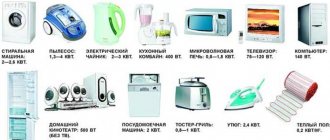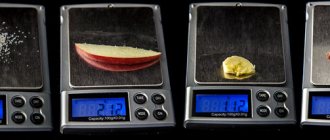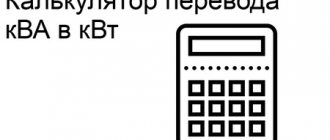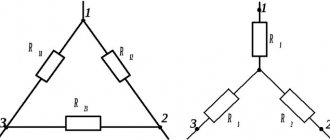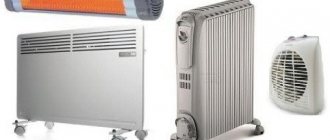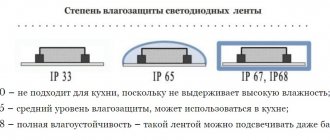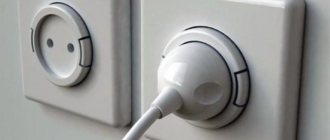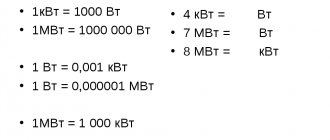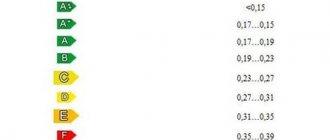What is watt
The unit value of electrical energy for the work done over a period of time is called a watt.
Named after the mechanic and inventor James Watt. Denoted by W or W. He was the first to propose the use of horsepower as a universal unit of measurement of machine performance.
Can be represented by the formula:
W = joule/second, or 1 W = 1 J/sec.
To determine the power of electrical machines, the following formula is used:
P=U*I. Voltage times current.
Electricity is measured by "U" in volts and "I" in amperes by the resulting power in watts.
Concepts and terms
The total power S(kVA) of the electric current, although it is a non-systemic unit, is used on the territory of the Russian Federation along with SI units. This value is designated as В*А, in the international format – V*A. When a current of variable nature flows in an electrical circuit, I = 1 A and U = 1 V, the total S = 1VA.
When direct electricity moves in a closed loop, we can only talk about active power P, it is measured in watts (W).
Units
How to correctly convert these units
A watt is equal to a kilogram multiplied by square meters and divided by cubic seconds. The prefix kilo denotes multiplication by 1000. The same principle applies to power indicators, that is, 1 kW contains 1000 W and 1000 volts. This means that 1 unit = 0.001 subunits. That is, if you convert the power, then a 3 kW electrical appliance will be equal to 3000 W.
Conversion formula
In electricity
To simplify measurements in electricity, a subunit is used. You can find out how many watts are in a kilowatt and convert the units by multiplying watts by 103 and dividing by 1000. To carry out the reverse conversion, you need to multiply kW by 103 or multiply known indicators by 1000.
Quantities in electricity
In heating
To measure thermal power, you need to use the joule. This is the work done by 1 newton per 1 meter. To convert joule to kW, you need to use the joule subunit. There are 0.239 kcal in 1 kJ. There are 4.1868 kJ in 1 kcal. There are 860 kcal in 1 kW. This means that 1000 kcal contains 1.163 kW per hour.
Heating measurements
Object of measurement
At the moment, any force can be measured in watts, not just electrical. For example, to measure motor vehicle power, watts are used. But often it is not they themselves that are used, but their derivatives. Similarly with meters and kilometers, grams and kilograms, 1 kW = 1000 W. Therefore, all electrical appliances, as a rule, have a pronounced power.
As for the ampere value, the most popular devices measured in it are uninterruptible power supplies and various industrial and construction power generators.
What is measured in quantities
How to convert watts to kilowatts
Household electrical appliances have different power ratings. It ranges from a few watts to several thousand watts. For convenience of calculation, they lead to a single value. This is usually a kilowatt, denoted kW.
To convert watts to kilowatts, you need to know how many watts are contained in 1 kW. The word “kilo” itself means a thousand. That is, one kilowatt of electricity contains 1000 watts.
For the convenience of converting one unit to another, there are various programs. But converting from one value to another is easy to do on your own.
For example, a house has several electricity consumers, a chandelier with three 60 W lamps, a 150 W TV and a 100 W stereo system. We get 3*60+150+100, the result is 430 W. We know that 1KW contains 1000W. Divide this value by 1000, we get 0.43 kW.
For clarity, we will make several calculations. The resulting conversion from W to kW will be tabulated.
| W | 5 | 90 | 100 | 250 | 500 | 750 | 1000 | 2500 | 10500 |
| kW | 0,005 | 0,09 | 0,1 | 0,25 | 0,5 | 0,75 | 1 | 2,5 | 10,5 |
Often it is necessary to perform the inverse function. Convert from kW to Watts. To do this, the power in kilowatts must be multiplied by 1,000. Let’s make calculations and put them in a table for clarity.
| kW | 5 | 2,5 | 1 | 0,85 | 0,4 | 0,25 | 0,08 | 0,007 |
| W | 5 000 | 2500 | 1000 | 850 | 400 | 250 | 80 | 7 |
Industrial enterprises use electricity consumers with a capacity of several thousand kilowatts. For convenience, the concept of megawatt has been introduced, denoted as mW. The prefix “mega” means 1,000,000. That is, 1 mW contains 1,000,000 W, or 1,000 kW.
Kilowatt and kilowatt-hour - what's the difference?
Along with the designation kilowatt, you can find the unit kilowatt per hour. For example, electricity meter readings are displayed in kWh values. Non-specialists do not distinguish between these concepts and believe that they are one and the same thing. However, these are completely different quantities.
Watt per hour is the amount of electricity produced or consumed per unit of time, denoted Wh.
For example, 1 kW hour means that the power receiver consumes 1 kW of electricity in 1 hour.
Kilowatt, unlike kWh, is a quantity indicating instantaneous power consumed or generated.
Converter
You can use an easy to use converter to calculate the values. A converter is a system that converts source data into a given value. All that is required from the user is to enter existing data in the field and click the start button on the service being used.
Note! There are various system converters. Some convert these watts, others directly into kilowatts.
Convector
How to calculate the total power of household appliances
The installed power of a house or cottage is important when calculating and selecting electrical wiring and machines. Without this parameter it is impossible to design the power supply of the house.
To find out the installed power, you need to select data on power consumption from the equipment passports. For example, as indicated on the plate.
| Name | Power, W |
| TV | 150 |
| Boiler | 1 500 |
| Electric furnace | 2 000 |
| Washing machine | |
| Fixtures (total number of light bulbs in the entire house) | 1 000 |
| Computer | 100 |
| TOTAL: | 3,750 W or 3.75 kW |
To correctly calculate the power supply of a house, the combination coefficient is taken into account. It indicates how many consumers are working simultaneously.
For installed power in a house, cottage, apartment up to 14 kW, a coefficient of 0.8 is used in the calculations. That is, the total value of the loads is taken and multiplied by 0.8. For our example, in the calculations we take a power equal to 3.75 * 0.8 = 3 kW.
How many watts are in a kilowatt?
A watt is a relatively small value to use exclusively in everyday life. The power of lamps in a residential area ranges from 10 to 100 W. Most household appliances consume between 1000 and 3000 watts. In a small production we are talking about tens of thousands of watts or more. Operating with numbers with 5 or 7 zeros is inconvenient, so there is a need for a larger unit of measurement.
In the description of devices the following designations are used:
- V.A;
- kW;
- kWh;
- MW.
Units of measurement that are multiples of a decimal factor were introduced into the international SI system. They are derived through the basic ones using multiplication and division by a factor divisible by 10. Some of them received their own names. Derived units are used along with basic ones.
The table shows the coefficient values and their corresponding names.
| coefficient | Name |
| 0,000000001 | nano |
| 0,000001 | micro |
| 0,001 | Milli |
| 0 | |
| 1000 | kilo |
| 1000000 | mega |
| 1000000000 | giga |
| 1000000000000 | tera |
| 1000000000000000 | peta |
Using this table, it is easy to answer the question of how many watts are contained in a kilowatt of electricity - 1000 watts.
Converting watts to kilowatts.
What is the difference between a kilowatt and a kilowatt hour?
Many consumers habitually refer to electricity consumption indicators recorded by an electric meter as kilowatts. But in fact, this indicator is measured in kilowatt-hours (kWh), which is not the same thing at all.
Energy consumption in kWh is determined by the amount of power expended during a certain time.
An example of such a calculation:
- an incandescent lamp of 0.06 kW is used for lighting;
- for 6 hours of operation (approximate operating time during the day), this device will consume electricity 0.06 × 6 = 0.36 kWh;
- per month, the consumption for the specified lamp will be 0.36 × 30 = 10.8 kW*h.
In a similar way, it is easy to calculate the total consumption of electrical energy per month, knowing the duration of switching on of a particular equipment and its power characteristics. Next, you can determine the amount of savings achieved through the use of less energy-consuming equipment and a frugal attitude to resource consumption.
Correct conversion of power units of electrical energy is very important for the consumer. This will ensure safe operation of the equipment and save energy consumption.
Application of value
According to GOST, kWh is the basic unit for keeping records of the amount of electrical energy used. Its main advantage is ease of use. The results when using it are the most acceptable. However, no one prohibits using multiple units if necessary, for example, megawatt-hour, gigawatt-hour.
GOST also established rules for writing the unit of measurement - “kilowatt-hour”. Its full name must be written using a hyphen. If a short designation in English or Russian letters is used, then before “h” and “ch” you need to put a dot in the middle of the line. In essence, such a point is a multiplication sign.
The power of devices powered by electricity, as well as the energy they consume per hour, is usually indicated on their body. In this case, the unit “watt” can be designated by the English letter “W”. The choice of one or another derived unit depends on the manufacturer.
You can often see household microwave ovens produced by different companies, the power and energy consumption of which are indicated on the housings in different units of measurement.
This could be kW-hours, kW, or even volt-amps. For example:
- If the designation “kW”, “kW” or “kVt” is present on the body of the microwave oven, then the thermal power of this device can be judged by the number located in front of them.
- If the symbols “kWh” and “kW h” are present on the case, this means that the manufacturer of the microwave oven has decided to indicate the electrical power that the device consumes during a certain period of its operation.
Total electrical power value
Sometimes it is necessary to calculate the total power of household consumers installed in the house. This is necessary for:
- correct choice of cable cross-section when installing electrical wiring;
- selection of control devices, including circuit breakers, electric meters, etc.;
- layout of the wiring system in the house.
Ultimately, correct accounting of the total energy intensity of household appliances ensures the operational reliability of electrical wiring and the safe operation of household electrical appliances.
To calculate the highest possible power of household electrical appliances, you should add up the number of watts indicated in the technical documentation of the equipment or directly on the equipment itself. When performing the calculation, all values must be converted accordingly to the same unit of measurement, taking into account the procedure described above.
The difference between kW and kW/hour
In everyday life, kW and kWh are often confused, using both units to measure power. Kilowatt characterizes the amount of work produced per unit of time. 1 W is 1 J (joule) of work done in 1 second. A kilowatt is equal to 1000 J/s.
Kilowatt hours indicate the amount of work done or energy expended. From the definition it follows that kWh is the work (energy) performed (consumed) within 1 hour by a device with a power of 1 kilowatt.
The simplest calculation shows how many kilowatts a 100 W lamp consumes.
Relation to base and multiple units of power
Watt refers to a derived unit of power, so in practice it is sometimes necessary to determine the value of a parameter in relation to the basic units of the international SI system. In technical calculations, the following correspondences to the basic values are used:
- W = kgm²/s³;
- L = Hm/s;
- W=VA
The parameter has universal application and is equally used in technical developments in various fields of activity.
Thermal engineering uses non-SI units to measure heat output in 1 cal/hour. Our considered value is related to it by the ratio: 1 W = 859.85 cal/hour.
Often, for the convenience of working with large power values of power plants and power groups, the word watt can be used with the prefixes “mega” or “giga”:
- megawatt is designated MW/MW and corresponds to 106 W;
- gigawatt (abbreviated GW/GW) is equal to 109 watts.
On the contrary, in low-current information networks, electronic devices and modern electronic equipment, power is measured in fractions of watts:
- milliwatts (mW, mW) – 10-3 W;
- microwatts (μW, μW) are equal to 10-6 W.
Using these ratios, it is always possible to convert most parameters into the required power units.
Main household energy consumers
Climate change and environmental degradation force us to think about saving energy at all levels. Many are making targeted efforts to reduce electricity consumption. To effectively save energy, you need to identify which appliances consume the most.
Of the main consumers of electricity, devices that operate continuously or for many hours attract attention. These include refrigerators and boilers. They can also include heating and heating systems. The next most energy consuming devices are lighting fixtures and water supply systems. Another group that deserves attention are powerful devices that work sporadically, but consume a lot of energy. This group includes vacuum cleaners, floor polishers with steam cleaning function, washing machines and dishwashers, as well as construction and installation tools.
Manufacturers of household and industrial appliances are constantly working to reduce energy consumption. About 25 years ago, a desktop computer consumed about 12 kWh per day. Today, this level is typical for powerful workstations or productive gaming desktops. A standard office PC consumes 2 kWh per day.
Refrigerators no older than 5 years require 1-1.5 kWh of energy per day. This value depends on the ambient temperature and the volume of the cooled space. An oil radiator, which is used as additional room heating, will increase consumption by 7-15 kWh, depending on the characteristics of the building and the outside temperature.
Other devices do not make a large contribution to the total consumption of electrical energy, with the exception of one-time work.
Main household energy consumers
Nowadays, even wealthy people are thinking about reducing energy costs - instead of conventional incandescent lamps in homes, you can increasingly see LED and energy-saving light bulbs. When choosing household appliances, you should pay attention to their efficiency. Almost every home has an iron, electric kettle, TV, refrigerator, etc. The refrigerator usually operates 24 hours a day, its consumption rate is 0.8-1.4 kW, depending on the size and temperature in the room. The daily electricity consumption of a TV is 2.5 kW, and that of a computer is 13.6 kilowatts. An electric kettle will consume 1 kW of energy in 20 minutes of operation. How much energy is consumed in your home?
What is a "kilowatt-hour"?
Kilowatt hours are units used to measure the amount of energy consumed by an electrical appliance in one hour. For example, consider the operation of a computer with a power of 0.67 kW. Let's say he worked for two hours. How much electricity did he use during this time? Everything is very simple: multiply 0.67 kW by two hours and get 1.34 kWh. An ordinary 100 W incandescent lamp consumes 0.1 kWh of energy per hour, respectively, if it is not turned off during the day, it will consume 2.4 kW.
Sources
- https://oschetchike.ru/elektroenergii/skolko-vatt-v-kilovatte
- https://rusenergetics.ru/polezno-znat/skolko-vatt-v-kilovatte
- https://knigaelektrika.ru/teoriya/kak-perevesti-kilovatty-v-vatty.html
- https://PoUchetu.ru/interesnoe/skolko-vatt-v-1-kvt
- https://www.calc.ru/kilovatt-v-vatt.html
- https://electrikagid.ru/electrobezopastnost/poschitaem-skolko-vatt-v-kilovatte.html
- https://amperof.ru/teoriya/skolko-vatt-v-kilovatte.html
What are kW and kVA
Electric power is a quantity that characterizes the transmission speed with the consumption or generation of electricity per time unit. The greater the force, the more work the electrical equipment can do in a unit of time. It can be complete, reactive and active.
kW and kVA
kW is the apparent electrical power and kVA is the active power according to the concept presented by Jace Watt. Accordingly, in the first case, one unit equals 1000 watts. One W is the power at which one joule of work can be done in one second. The portion of the total force transmitted to the load during a specific current period is active power. It is calculated as the product of the effective values of the current with voltage and the angular cosine with the phase shift around them.
Detailed definition of kilowatt
A kilowatt ampere is the total power that is consumed by any electrical equipment, while a kilowatt is considered the active energy that is expended to do useful work. Total strength is the sum of active and reactive indicators.
Note! All electrical devices that have consumer status are divided into several categories:
- active,
- reactive.
The first include incandescent lamps with heaters and electric stoves. The second includes air conditioners with televisions, drills and fluorescent lamps.
Detailed definition of kilowatt ampere


